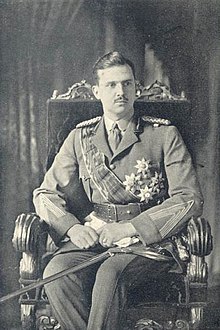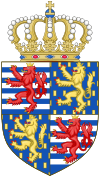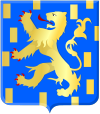Not to be confused with Prince Félix of Luxembourg.
| Félix of Bourbon-Parma | |||||
|---|---|---|---|---|---|
 1926 portrait 1926 portrait | |||||
| Prince consort of Luxembourg | |||||
| Tenure | 6 November 1919 – 12 November 1964 | ||||
| Born | (1893-10-28)28 October 1893 Schwarzau am Steinfeld, Austria | ||||
| Died | 8 April 1970(1970-04-08) (aged 76) Fischbach Castle, Luxembourg | ||||
| Burial | Notre-Dame Cathedral | ||||
| Spouse |
Charlotte, Grand Duchess of Luxembourg
(m. 1919) | ||||
| Issue | |||||
| |||||
| House | Bourbon-Parma | ||||
| Father | Robert I, Duke of Parma | ||||
| Mother | Infanta Maria Antonia of Portugal | ||||
Prince Félix of Bourbon-Parma (later Prince Félix of Luxembourg; 28 September 1893 – 8 April 1970) was the husband of Charlotte, Grand Duchess of Luxembourg and the father of her six children, including her successor Jean, Grand Duke of Luxembourg. By birth to his father Robert I, Duke of Parma, he was a member of the House of Bourbon-Parma and one descendant of King Philip V of Spain. Prince Félix was the longest-serving consort of Luxembourg.
Early life
Prince Félix was one of the 24 children of the deposed Robert I, Duke of Parma, being the duke's sixth child and third son by his second wife, Maria Antonia of Portugal. His maternal grandparents were Miguel of Portugal and Adelaide of Löwenstein-Wertheim-Rosenberg. He was born in Schwarzau am Steinfeld.
He was also the younger brother (by sixteen months) of Empress Zita of Austria. Of the twelve children of Duke Robert's first marriage to Maria-Pia of the Two Sicilies, three died as infants, six had learning difficulties, and only three married. Despite the loss of his throne, Duke Robert and his family enjoyed considerable wealth, travelling in a private train of more than a dozen cars among his castles at Schwarzau am Steinfeld near Vienna, Villa Pianore [it] in northwest Italy, and the magnificent Château de Chambord in France.
Less than four months after Robert's death in 1907 the Grand Marshal of the Austrian Court declared six of the children of his first marriage legally incompetent, at the behest of Duchess Maria Antonia. Nonetheless, Robert's primary heir was Elias, Duke of Parma, (1880–1959), the youngest son of the first marriage and the only one to father children of his own. Duke Elias also became the legal guardian of his six elder siblings. Although Félix's elder brothers, Prince Sixte and Prince Xavier, eventually sued their half-brother Duke Elias to obtain a greater share of the ducal fortune, they lost in the French courts, leaving Prince Félix with modest prospects.
During the Battle of Caporetto, Prince Félix accompanied his brother-in-law Charles I of Austria, who had been visiting troops on the Italian front, on a return journey to Trieste. When they were crossing the Torre (river), the Emperor's car became stuck in the stream and it was deemed necessary to carry the Emperor to the river bank. However, the driver and aide-de-camp, who were carrying the Emperor, slipped and they were all caught in the current. Seeing this, Prince Félix, along with several chauffeurs, jumped into the river and, with the help of some planks, brought the Emperor and others to shore.
Félix served in the Austrian Dragoons as Lieutenant and Captain, but resigned his commission in November 1918, when Austria-Hungary dissolved.
Marriage to Grand Duchess Charlotte
On 6 November 1919 in Luxembourg, the prince married his first cousin Grand Duchess Charlotte of Luxembourg, having been admitted to the nobility of Luxembourg and also made Prince of Luxembourg by Grand Ducal decree the day before. Unlike some European consorts, Félix neither adopted his wife's dynastic surname (of Nassau), nor relinquished his own title and name "Prince of Bourbon-Parma". His traditional style as a Bourbon prince of the Parmesan branch is the reason that cadet members of the Grand Ducal Family of Luxembourg enjoy the style of Royal Highness (but separately that style belongs to the Luxembourg monarch and heir apparent by right, as the historical prerogative of grand-ducal dynasties).
Felix was president of the Luxembourg Red Cross between 1923 and 1932 and again between 1947 and 1969. He was also Colonel of the Luxembourg Volunteers Company since 1920 and Inspector-General of the Luxembourg Army between 1945 and 1967.
Urban legend has it that Félix lost the Grünewald, a forest owned by the Grand Duchess, at a casino in 1934, but this is false; part of the property was sold, along with Berg Castle, to the Luxembourgian government, with the revenue paying for the upkeep of the grand-ducal household, and was not spent on personal consumption, let alone gambling losses.
During World War II the grand ducal family left Luxembourg shortly before the arrival of Nazi troops, settling in France until the capitulation, in June 1940. Subsequently, the family and the Grand Duchess' ministers received transit visas to Portugal from the Portuguese consul Aristides de Sousa Mendes, in June 1940. They arrived at Vilar Formoso on 23 June 1940. After travelling through Coimbra and Lisbon, the family first stayed in Cascais, in Casa de Santa Maria, owned by Manuel Espírito Santo, who was then the honorary consul for Luxembourg in Portugal. By July they had moved to Monte Estoril, staying at the Chalet Posser de Andrade. On 10 July 1940, Félix, together with his children, Hereditary Grand Duke Jean, Princess Elisabeth, Princess Marie Adelaide, Princess Marie Gabriele, Prince Charles and Princess Alix, the nanny Justine Reinard and the chauffeur Eugène Niclou, along with his wife Joséphine, boarded the S.S. Trenton headed for New York City, after which they moved to Canada.
Death
Prince Félix died at Fischbach Castle on 8 April 1970. His funeral mass was held at the Cathedral of Notre-Dame and he was later buried in the crypt of the cathedral.
Marriage and children
| This section does not cite any sources. Please help improve this section by adding citations to reliable sources. Unsourced material may be challenged and removed. (November 2021) (Learn how and when to remove this message) |
On 6 November 1919 in Luxembourg, he married Charlotte, Grand Duchess of Luxembourg. They had six children:
- Jean, Grand Duke of Luxembourg (1921–2019), who married HRH Princess Joséphine-Charlotte of Belgium (1927–2005), and had issue.
- Princess Elisabeth of Luxembourg (1922–2011), who married HSH Franz, Duke of Hohenberg (1927–1977), and had issue.
- Princess Marie Adelaide of Luxembourg (1924–2007), who married Count Karl Josef Henckel von Donnersmarck (1928–2008), and had issue.
- Princess Marie Gabrielle of Luxembourg (1925–2023), who married Knud Johan, Count of Holstein-Ledreborg (1919–2001), and had issue.
- Prince Charles of Luxembourg (1927–1977), who married Joan Douglas Dillon (born 1935), the former wife of James Brady Moseley, and had issue.
- Princess Alix of Luxembourg (1929–2019), who married HH Antoine, 13th Prince of Ligne (1925–2005), and had issue.
Titles, honours and awards
- 28 October 1893 – 5 November 1919: His Royal Highness Prince Felix of Bourbon-Parma
- 5 November 1919 – 6 November 1919: His Royal Highness Prince Felix of Luxembourg
- 6 November 1919 – 12 November 1964: His Royal Highness The Prince Consort of Luxembourg
- 12 November 1964 – 8 April 1970: His Royal Highness Prince Felix of Luxembourg
Honours
- National
 Luxembourg: Knight of the Order of the Gold Lion of the House of Nassau
Luxembourg: Knight of the Order of the Gold Lion of the House of Nassau Luxembourg: President of the Luxembourg Red Cross
Luxembourg: President of the Luxembourg Red Cross Parmese Ducal Family: Grand Cross of the Order of St. Louis for Civil Merit
Parmese Ducal Family: Grand Cross of the Order of St. Louis for Civil Merit
- Foreign
 Kingdom of Albania Knight Grand Cross of the Order of Fidelity (1931)
Kingdom of Albania Knight Grand Cross of the Order of Fidelity (1931)
 Austro-Hungarian Imperial and Royal Family: Grand Cross of the Royal Hungarian Order of St. Stephen (1917)
Austro-Hungarian Imperial and Royal Family: Grand Cross of the Royal Hungarian Order of St. Stephen (1917) Belgium: Grand Cordon of the Order of Leopold
Belgium: Grand Cordon of the Order of Leopold Netherlands: Grand Cross of the Order of the Netherlands Lion
Netherlands: Grand Cross of the Order of the Netherlands Lion Norway: Grand Cross of the Royal Norwegian Order of St. Olav (1964)
Norway: Grand Cross of the Royal Norwegian Order of St. Olav (1964) Portugal: Grand Cross of the Military Order of St. Benedict of Aviz (24 February 1950)
Portugal: Grand Cross of the Military Order of St. Benedict of Aviz (24 February 1950) Sweden: Knight of the Royal Order of the Seraphim (18 July 1951)
Sweden: Knight of the Royal Order of the Seraphim (18 July 1951) Thailand: Knight of the Order of the Royal House of Chakri (17 October 1960)
Thailand: Knight of the Order of the Royal House of Chakri (17 October 1960)
Ancestry
| This section does not cite any sources. Please help improve this section by adding citations to reliable sources. Unsourced material may be challenged and removed. (November 2021) (Learn how and when to remove this message) |
| Ancestors of Prince Felix of Bourbon-Parma |
|---|
Patrilineal descent
| This section does not cite any sources. Please help improve this section by adding citations to reliable sources. Unsourced material may be challenged and removed. (November 2021) (Learn how and when to remove this message) |
| Patrilineal descent |
|---|
|
Felix's patriline is the line from which he is descended father to son. Patrilineal descent is the principle behind membership in royal houses, as it can be traced back through the generations - which means that if Prince Felix were to choose an historically accurate house name it would be Robertian, as all his male-line ancestors have been of that house. Felix is a member of the House of Bourbon-Parma, a sub-branch of the House of Bourbon-Spain, itself originally a branch of the House of Bourbon, and thus of the Capetian dynasty and of the Robertians. Felix's patriline is the line from which he is descended father to son. It follows the Dukes of Parma as well as the Kings of Spain, France, and Navarre. The line can be traced back more than 1,200 years from Robert of Hesbaye to the present day, through Kings of France & Navarre, Spain and Two-Sicilies, Dukes of Parma and Grand-Dukes of Luxembourg, Princes of Orléans and Emperors of Brazil. It is one of the oldest in Europe.
|
Footnotes and references
- Arrêté grand-ducal du 17 juillet 1945 Archived 3 March 2016 at the Wayback Machine – "Legilux" Legal information website of the Luxembourg government
- ^ birth record in church book of parish Schwarzau am Steinfeld, p. 02-Taufe_0031
- Polzer-Hoditz, Arthur (1930). The Emperor Karl. Translated by Tait, D. F.; Flint, F. S. Houghton Mifflin Company. pp. 371–372.
- per Arrêté grand-ducal du 5 novembre 1919. (Published in Mémorial A n° 74 de 1919).
- Juncker, Jean-Claude (15 February 2007). "Réponse à la question parlementaire no.1220 du 4 août 2006 de Messieurs les Députés Gast Gibéryen et Roby Mehlen" (PDF) (in French). Investigateur. Archived from the original (PDF) on 27 September 2007. Retrieved 28 June 2007.
- “A fuga da família grã-ducal”, by Margarida de Magalhães Ramalho (2019)
- Bernier Arcand, Philippe (2010). "L'exil québécois du gouvernement du Luxembourg" (PDF). Histoire Québec. 15 (3): 19–26 – via Erudit.
- Albanian Royal Court
- "Ritter-Orden: St. Stephan-orden", Hof- und Staatshandbuch der Österreichisch-Ungarischen Monarchie, 1918, p. 56, retrieved 2 November 2019
- "Den kongelige norske Sanct Olavs Orden", Norges Statskalender for Aaret 1970 (in Norwegian), Oslo: Forlagt av H. Aschehoug & Co. (w. Nygaard), 1970, pp. 1240–1241 – via runeberg.org
- "ENTIDADES ESTRANGEIRAS AGRACIADAS COM ORDENS PORTUGUESAS - Página Oficial das Ordens Honoríficas Portuguesas".
- Royal Thai Government Gazette (28 December 1960). "แจ้งความสำนักนายกรัฐมนตรี เรื่อง พระราชทานเครื่องราชอิสริยาภรณ์" (PDF) (in Thai). Archived from the original (PDF) on 5 April 2015. Retrieved 8 May 2019.
{{cite journal}}: Cite journal requires|journal=(help)
| Prince Felix of Bourbon-Parma House of Bourbon-ParmaCadet branch of the House of BourbonBorn: 28 October 1893 Died: 31 July 1942 | ||
| Luxembourgish royalty | ||
|---|---|---|
| VacantTitle last held byMarie Anne of Portugal as grand duchess |
Prince consort of Luxembourg 1919–1964 |
Succeeded byJoséphine-Charlotte of Belgiumas grand duchess |
| Princes of Parma | |
|---|---|
| 1st generation | |
| 2nd generation | |
| 3rd generation | |
| 4th generation | |
| 5th generation | |
| 6th generation | |
| 7th generation |
|
| 8th generation |
|
| 9th generation | |
| 10th generation | |
| 11th generation | |
| 12th generation | |
| 13th generation | |
| 14th generation | |
| 15th generation | |
| 16th generation | |
| |
| Princes of Luxembourg | ||
|---|---|---|
| Generations are numbered from the accession of Adolphe as Grand Duke of Luxembourg in 1890. | ||
| 1st generation |  | |
| 2nd generation | ||
| 3rd generation | ||
| 4th generation | ||
| 5th generation | ||
| 6th generation | ||
| *also a prince of Nassau ^also a prince of Bourbon-Parma §not a Luxembourgian prince by birth, but created Prince Consort | ||
| Princes of Nassau | ||
|---|---|---|
| Generations are numbered from the accession of William as Duke of Nassau in 1816. | ||
| 1st generation |  | |
| 2nd generation | ||
| 3rd generation | ||
| 4th generation | ||
| 5th generation | ||
| 6th generation | ||
| 7th generation | ||
| *also a prince of Luxembourg ^also a prince of Bourbon-Parma §not a Luxembourgian prince by birth, but created Prince Consort | ||
| Ducal consorts of Nassau | |
|---|---|
María Teresa Mestre y Batista-Falla*^ (2000-)
| |
| * denotes titular Duchess ** denotes titular Prince consort ^ Also Grand Duchess of Luxembourg # Also Prince consort of Luxembourg ¶ Also Princess consort of Nassau-Weilburg |
| Consorts of Luxembourg | ||||||||||||||||||||
|---|---|---|---|---|---|---|---|---|---|---|---|---|---|---|---|---|---|---|---|---|
| ||||||||||||||||||||
| ||||||||||||||||||||
| ||||||||||||||||||||
- People from Neunkirchen District, Austria
- House of Bourbon-Parma
- Members of the Council of State of Luxembourg
- Princes of Bourbon-Parma
- Princes of Luxembourg
- Grand ducal consorts of Luxembourg
- Austro-Hungarian military personnel of World War I
- Luxembourgian people of World War II
- Grand Crosses of the Order of Aviz
- Grand Crosses of the Order of Saint Stephen of Hungary
- Burials at Notre-Dame Cathedral, Luxembourg
- 1893 births
- 1970 deaths
- Sons of dukes


